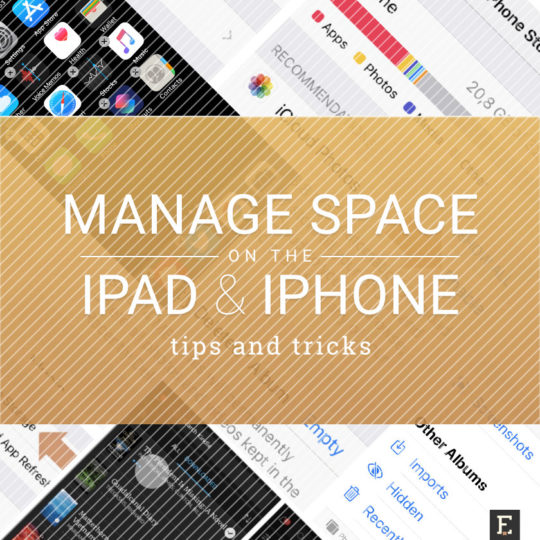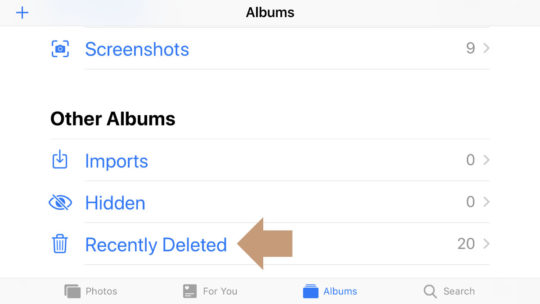Does My Kindle App Take So Much Storage
Tips & more
A newbie's guide to manage storage space on the iPad and iPhone

A few easy tips to clean your iOS device from unused apps and better manage the storage space.
One of the reasons your iPad or iPhone gets slower and slower over time is that there is less and less space left on it.
Remember? When you buy the new iPad or iPhone, you spend the first few months playing with the apps. You were testing how your favorite apps perform on the new device or trying new apps.
It's been a year or more since you were intensively exploring your new iPad, and some of these apps were not opened since then.
It's a good habit to clean the iPad or iPhone from unused apps or poor photos. In this simple guide, you will quickly learn how to refresh your device without too much effort.
How to manage storage on the iPad and iPhone
The first thing you can do is check out how much space is left on your iPad – how much is taken by apps, and how much by photos and videos.
You can quickly check out how much space is left by going to Settings app, and then selecting "iPad Storage" ("iPhone Storage").

Too much space is taken by the apps you don't use? Too many videos shot, and your iPhone can barely open an app? It's time to make some space.
1. Delete some apps
You most probably know how to do it, so here is just a quick recap.
To delete the iOS app, go the Home screen on your iPad or iPhone:
- Tap and hold the app's icon gently until it starts to jiggle.
- Tap the small "Close" icon in the top left corner of the app.
- Press Home button to close app management mode.

2. Offload some apps
Offloading the app is a great way to free up space, and you should use it (rather than deleting the app completely) if you think you will use the app some time soon.
The best thing is that after you offload the app, it remains on the Home screen. There is a small cloud icon next to the app's name.
When you want the app back, simply tap its icon and the download will start immediately. There is no need to go to the App Store, find the app and download it as new.
The app will open with the exactly the same settings as before. There is no need to customize it or sign in again.
How to offload an iOS app on your iPad or iPhone?
- Open Settings app, then tap "General," then "iPhone Storage."
- Scroll down – you will see a list of apps, together with space they take. Tap the app you want to offload, and then tap "Offload App."

3. Remove downloaded content from the apps
Removing or offloading some apps may not be the solution if you are using these apps daily.
What can we do, then? Let's remove unused content directly from these apps.
Many apps, such as Apple Music, Netflix, Kindle, or Audible, let users download content for offline use.
The thing is that you don't need your entire music on the iPhone if you are going to jog for 30 minutes – you just need music for 30 minutes. You don't need all your Audible audiobooks on your iPad for a 6-hour flight with Air Mode on – you just need one or two audiobooks.
All you have to do is to manage in-app content more often and leave only the songs, movies, or books you are truly going to use in the next few days.
Each app has a different way to remove the downloaded content. For instance, in the Netflix app, you can remove all downloaded movies and tv shows in the Settings, or one by one in the Download tab.
In the Kindle app, you can do it right in the Library view by tapping and holding the book and selecting "Remove from Device" in the dialog box.

4. Empty Camera Roll trash
Deleting a photo from Camera Roll doesn't automatically free up disc space. The photos are still there – they are stored for the next 30 days in the Camera Roll trash.
There are two ways to empty Recently Deleted photos and videos.
First option
- Go to Settings app, tap "General," then "iPhone Storage" (or "iPad Storage").
- Tap "Empty" that's next to "Recently Deleted Album."

Second option
- Open Photos app, tap "Albums" on the bottom navigation bar, and scroll down to see "Recently Deleted."
- Open the album, and tap "Select" in the top right corner. Then tap "Delete All" in the bottom left.

5. Enable cloud storage
Cloud storage is a great way to both back up photos and videos and better manage storage on the iPad or iPhone.
The easiest way to enable cloud storage is to use the Apple's built in solution – via iCloud.
- Open Settings app, tap "General," then "iPhone Storage."
- Tap "Enable" next to "iCloud Photos."

• • •
We removed a comment system to increase your privacy and reduce distractions. If you'd like to discuss this article, we are waiting for you on Twitter, Facebook, and Pinterest. You can also follow us on Google News or grab our RSS feed.
Are you interested in the iPad and iPhone? Keep exploring:
12 best ebooks for your winter 2021-22 reading list
– October 20, 2021
Basic iPad 2021 features, Q&A, and full specs
– September 16, 2021
24 best iPad 10.2 case covers – the ultimate 2021-22 overview
– September 15, 2021
23 best iPad Pro 11 2021 cases that meet versatile needs
– June 20, 2021
Finally, the Kindle app for iPhone and iPad gets the automatic theme switcher
– April 24, 2021
Here are the most interesting iPad mini 6 case covers you can get in 2021
In this updated overview, we list the best covers and sleeves that are compatible with the newest iPad mini 6 released in 2021.
iPad mini 6 covers
About Piotr Kowalczyk
Ad-man who decided to devote his life to books. Founder of Ebook Friendly, ebook enthusiast, and self-published short story author. Prefers reading on his iPhone, but when it comes to history books – Piotr always picks print.
Info Posts Twitter Mail
• • •
Secure social sharing
We removed all social buttons, but if you wish to share this post on Twitter or Facebook, use the box below which will securely open the sharing panel in a new browser tab.
A newbie's guide to manage storage space on the iPad and iPhone https://ebookfriendly.com/how-to-better-manage-storage-space-ipad-iphone/ via @ebookfriendly
+ Twitter + Facebook
Before you go
• • •
Instead of comments
The Ballad of Songbirds and Snakes
by Suzanne Collins
Part 1: The Mentor
Coriolanus released the fistful of cabbage into the pot of boiling water and swore that one day it would never pass his lips again. But this was not that day. He needed to eat a large bowl of the anemic stuff, and drink every drop of broth, to prevent his stomach from growling during the reaping ceremony. It was one of a long list of precautions he took to mask the fact that his family, despite residing in the penthouse of the Capitol's most opulent apartment building, was as poor as district scum. That at eighteen, the heir to the once-great house of Snow had nothing to live on but his wits.
His shirt for the reaping was worrying him. He had an acceptable pair of dark dress pants bought on the black market last year, but the shirt was what people looked at. Fortunately, the Academy provided the uniforms it required for daily use. For today's ceremony, however, students were instructed to be dressed fashionably but with the solemnity the occasion dictated. Tigris had said to trust her, and he did. Only his cousin's cleverness with a needle had saved him so far. Still, he couldn't expect miracles.
The shirt they'd dug from the back of the wardrobe—his father's, from better days—was stained and yellowed with age, half the buttons missing, a cigarette burn on one cuff. Too damaged to sell in even the worst of times, and this was to be his reaping shirt? This morning he had gone to her room at daybreak, only to find both his cousin and the shirt missing. Not a good sign. Had Tigris given up on the old thing and braved the black market in some last-ditch effort to find him proper clothing? And what on earth would she possess worth trading for it? Only one thing—herself—and the house of Snow had not yet fallen that far. Or was it falling now as he salted the cabbage?
326 words read…
+ Kindle + Audible
Tips for users
iPad
If you are an Apple geek, or plan to buy an iPad or iPhone.
Explore
• • •
Devices are not dangerous for literature. People can be dangerous for literature. People, for example, who do not read.
– László Krasznahorkai –
• • •
Featured
"Libraries matter" fitted scoop t-shirt and other library merch items
Express that you love and support libraries by getting this vintage-style artwork that's available on almost 70 merch items, including clothes, home decor, and office accessories.
Average rating: 4.5/5
Redbubble $19.95
Does My Kindle App Take So Much Storage
Source: https://ebookfriendly.com/how-to-better-manage-storage-space-ipad-iphone/
Posted by: mcleandentelf1969.blogspot.com

0 Response to "Does My Kindle App Take So Much Storage"
Post a Comment